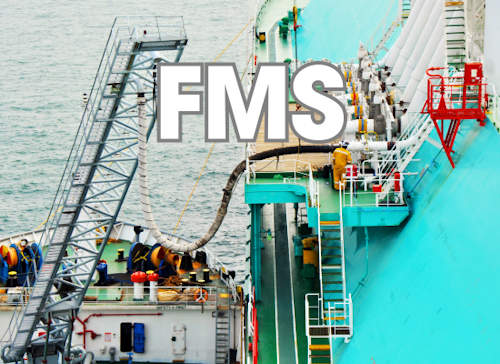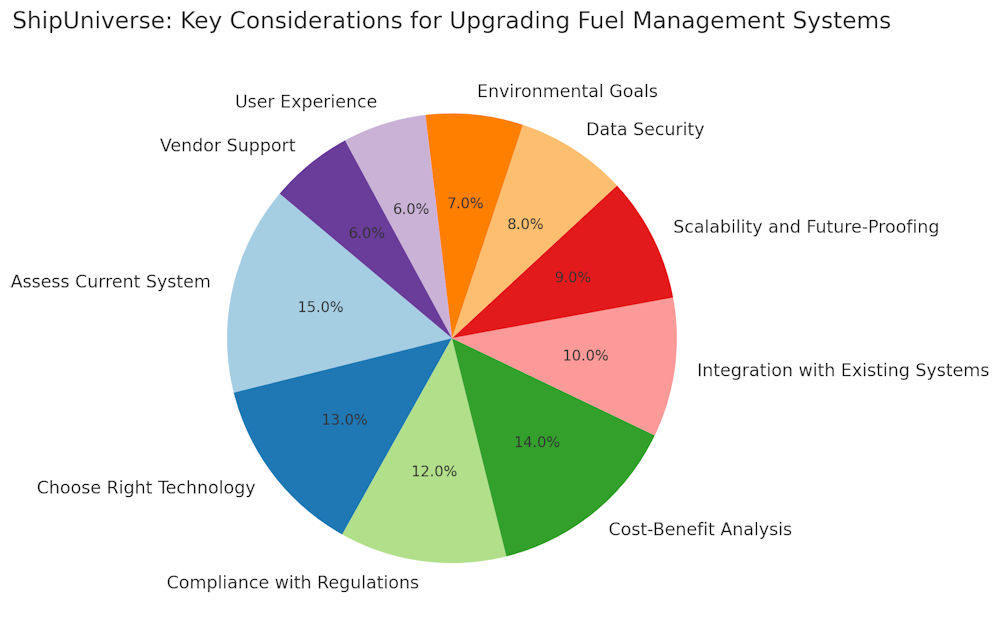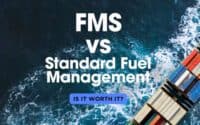Top 10 Considerations When Upgrading a Ship’s Fuel Management System

Upgrading a ship’s fuel management system is a critical step toward enhancing efficiency, reducing operational costs, and meeting stringent environmental regulations. For ship and fleet owners, making informed decisions about this upgrade can significantly impact the bottom line. This guide covers the top considerations to ensure a successful transition, from assessing current system performance to selecting the right technology and ensuring robust vendor support.
* Please send feedback/suggestions to editor @ shipuniverse.com

1. Assessing Your Current System’s Performance
Before diving into the upgrade, it’s essential to thoroughly assess your existing fuel management system. This involves understanding its strengths, weaknesses, and overall performance. Start by gathering data on fuel consumption, efficiency, and any recurring issues or maintenance problems.
- Data Collection: Use historical data to identify patterns in fuel usage and inefficiencies. Look at fuel consumption during different operating conditions and compare it with benchmarks.
- System Audit: Conduct a comprehensive audit to evaluate the system’s current condition. This may involve consulting with a marine engineer or a specialist in fuel management systems.
- Identify Pain Points: Pinpoint specific areas where the system falls short. Is it inaccurate fuel monitoring? Frequent maintenance issues? Understanding these pain points will guide you in selecting the right upgrades.
By understanding your current system’s performance, you can make targeted improvements rather than overhauling the entire setup unnecessarily.
2. Choosing the Right Technology
The maritime industry is constantly evolving, and so is the technology used in fuel management systems. When upgrading, selecting the right technology is paramount. Here are some modern options to consider:
- Advanced Fuel Flow Meters: These devices offer precise measurement of fuel consumption, providing real-time data that can help in making informed decisions.
- Integrated Monitoring Systems: These systems combine fuel monitoring with other critical parameters like engine performance, speed, and weather conditions. Integrated systems provide a holistic view of the ship’s performance, aiding in optimizing fuel efficiency.
- Software Solutions: Modern fuel management software can analyze data and provide actionable insights. Look for software that offers predictive analytics, automated reporting, and seamless integration with existing ship systems.
Choosing the right technology involves balancing cost, compatibility with existing systems, and the specific needs of your operations. It’s also worth considering the ease of use and the level of training required for your crew.
3. Compliance with Environmental Regulations
One of the driving factors behind upgrading a fuel management system is the need to comply with stringent environmental regulations. The International Maritime Organization (IMO) has set ambitious targets for reducing greenhouse gas emissions from ships, making compliance more critical than ever.
- Emission Control Areas (ECAs): Ensure that your upgraded system can help you meet the emission standards in ECAs. This might involve monitoring sulfur content in fuel and adjusting consumption patterns accordingly.
- Data Reporting: New regulations often require detailed reporting of fuel consumption and emissions. Choose a system that simplifies compliance by automating data collection and reporting.
- Sustainable Practices: Consider incorporating sustainable fuel options such as LNG or biofuels into your management system. This not only helps in regulatory compliance but also enhances your ship’s environmental credentials.
Staying ahead of regulatory changes is crucial. A proactive approach to compliance can prevent costly fines and ensure smoother operations in international waters.
4. Cost-Benefit Analysis
Upgrading a fuel management system involves a significant financial investment. To make a well-informed decision, conducting a thorough cost-benefit analysis is crucial. Here’s what you need to consider:
- Initial Investment: Calculate the upfront costs of purchasing and installing the new system. This includes hardware, software, and any necessary modifications to existing infrastructure.
- Operational Savings: Estimate the potential savings from improved fuel efficiency, reduced maintenance costs, and better route planning. Look at both short-term and long-term benefits.
- Return on Investment (ROI): Determine the payback period by comparing the initial investment with the projected savings. A detailed ROI analysis will help justify the upgrade to stakeholders and ensure that the investment aligns with your financial goals.
- Funding Options: Explore available financing options, grants, or incentives for adopting environmentally friendly technologies. Many organizations and governments offer financial support to encourage sustainable practices in maritime operations.
A comprehensive cost-benefit analysis ensures that the upgrade is financially viable and provides a clear picture of the economic advantages of the new system.
5. Integration with Existing Systems
When upgrading your fuel management system, seamless integration with existing shipboard systems is essential to avoid operational disruptions and maximize efficiency. Here are key integration considerations:
- Compatibility: Ensure that the new system is compatible with your current onboard equipment, including engines, navigation systems, and other monitoring devices. Incompatibility can lead to data inconsistencies and operational issues.
- Data Integration: The new system should integrate smoothly with existing data management platforms. This includes the ability to merge data from various sources, such as fuel flow meters, GPS, and engine performance monitors, into a single coherent system.
- Crew Training: Assess the training requirements for your crew. The upgraded system should be user-friendly, but adequate training is essential to ensure that the crew can effectively operate and maintain the new technology.
- Vendor Support: Choose a vendor that provides robust support and after-sales service. This includes installation assistance, regular maintenance, and prompt troubleshooting to ensure smooth integration and operation.
Successful integration minimizes downtime and leverages the full potential of your upgraded fuel management system, enhancing overall operational efficiency.
6. Scalability and Future-Proofing
As technology advances and regulations evolve, it’s important to choose a fuel management system that can adapt to future changes. Consider the following aspects to ensure scalability and future-proofing:
- Modular Design: Opt for a system with a modular design that allows for easy upgrades and expansions. This flexibility ensures that you can incorporate new technologies or features as they become available without overhauling the entire system.
- Software Updates: Ensure that the vendor provides regular software updates to keep the system up to date with the latest advancements and regulatory requirements. This includes enhancements in data analytics, user interface improvements, and security updates.
- Regulatory Compliance: Choose a system that can easily adapt to future regulatory changes. This includes the ability to integrate with new reporting requirements, emission standards, and fuel types.
- Long-Term Support: Verify that the vendor offers long-term support and maintenance services. A reliable support system ensures that your investment remains protected and operationally efficient for years to come.
By considering scalability and future-proofing, you can ensure that your upgraded fuel management system remains relevant and effective in the face of evolving industry demands and technological advancements.
7. Data Security and Cybersecurity
With the increasing reliance on digital systems and data integration, ensuring the security of your fuel management system is paramount. Here’s what to keep in mind:
- Data Protection: Implement robust data encryption methods to protect sensitive information from unauthorized access. This helps in securing fuel consumption data, engine performance metrics, and other critical information.
- Cybersecurity Measures: Invest in advanced cybersecurity measures to safeguard against cyber threats. This includes firewalls, intrusion detection systems, and regular security audits to detect and mitigate potential vulnerabilities.
- Access Control: Establish strict access control protocols to ensure that only authorized personnel can access and manipulate the system. Use role-based access controls and two-factor authentication to enhance security.
- Regular Updates: Keep the system updated with the latest security patches and updates to defend against new vulnerabilities. Ensure that your vendor provides timely updates and support to maintain the system’s security integrity.
By prioritizing data security and cybersecurity, you can protect your investment and ensure the reliable operation of your upgraded fuel management system.
8. Environmental and Sustainability Goals
Aligning your fuel management system upgrade with broader environmental and sustainability goals can enhance your company’s reputation and compliance efforts. Consider these aspects:
- Emission Monitoring: Ensure the system can accurately monitor and report emissions, helping you meet environmental regulations and improve sustainability. This includes tracking CO2, NOx, and SOx emissions.
- Green Technologies: Consider integrating green technologies, such as alternative fuels (e.g., LNG, biofuels) or emission reduction systems (e.g., scrubbers, catalytic converters), into your fuel management strategy. These technologies can significantly reduce your environmental footprint.
- Sustainability Reporting: Choose a system that supports detailed sustainability reporting, allowing you to communicate your environmental efforts to stakeholders and regulatory bodies. This can improve your company’s image and help you stay ahead of regulatory requirements.
Integrating environmental and sustainability goals into your fuel management system not only ensures compliance but also promotes a positive corporate image and contributes to global environmental efforts.
9. User Experience and Interface
The usability of the fuel management system can significantly impact its effectiveness and the ease with which your crew can adopt it. Focus on the following:
- Intuitive Interface: Select a system with a user-friendly and intuitive interface that simplifies operation and reduces the learning curve for the crew. A well-designed interface can enhance efficiency and minimize errors.
- Customizability: Ensure the system allows for customization to meet the specific needs of your operations and crew preferences. This includes customizable dashboards, alerts, and reports tailored to your requirements.
- Training Programs: Provide comprehensive training programs to ensure the crew can efficiently use the new system, maximizing its potential benefits. Ongoing training and support are essential for keeping the crew up-to-date with system functionalities and best practices.
By focusing on user experience and interface, you can ensure that your crew quickly adapts to the new system, enhancing overall operational efficiency and effectiveness.
10. Vendor Support and Reliability
Choosing the right vendor for your fuel management system upgrade is as important as the technology itself. The level of support and reliability provided by the vendor can significantly impact the success of the upgrade. Here’s what to consider:
- Reputation and Track Record: Research the vendor’s reputation and track record in the maritime industry. Look for customer reviews, case studies, and testimonials to gauge their reliability and performance.
- Support Services: Ensure the vendor offers comprehensive support services, including installation assistance, training, regular maintenance, and prompt troubleshooting. A reliable support system is crucial for addressing any issues that arise during and after the upgrade.
- Service Level Agreements (SLAs): Review the SLAs provided by the vendor to understand the level of service you can expect. This includes response times for support requests, availability of spare parts, and guarantees for system uptime.
- Future-Proofing and Updates: Choose a vendor committed to continuous improvement and innovation. They should offer regular updates and enhancements to keep your system current with the latest technological advancements and regulatory changes.
- Training and Documentation: Ensure the vendor provides thorough training for your crew and detailed documentation for the system. This includes user manuals, troubleshooting guides, and access to training resources.
By selecting a vendor with a strong reputation, comprehensive support services, and a commitment to innovation, you can ensure a smooth and successful upgrade of your ship’s fuel management system. A reliable vendor partnership is key to maintaining optimal system performance and achieving long-term operational benefits.
Fuel Management System Suppliers
ABB Marine & Ports
- Website: ABB Marine & Ports
- Description: ABB is a leading global technology company that energizes the transformation of society and industry to achieve a more productive, sustainable future. ABB Marine & Ports offers comprehensive fuel management solutions that include advanced fuel monitoring and efficiency optimization systems, integrated with their broader suite of maritime technologies.
Caterpillar Marine
- Website: Caterpillar Marine
- Description: Caterpillar Marine provides industry-leading fuel management systems designed to optimize fuel consumption and reduce emissions. Their solutions include fuel flow meters, monitoring systems, and analytics software, all backed by Caterpillar’s extensive experience in the maritime industry.
DNV GL
- Website: DNV GL
- Description: DNV GL is a global quality assurance and risk management company. Their fuel management solutions are part of their comprehensive suite of maritime services, which include performance monitoring, analytics, and sustainability strategies aimed at improving fuel efficiency and reducing environmental impact.
Kongsberg Maritime
- Website: Kongsberg Maritime
- Description: Kongsberg Maritime provides cutting-edge technology and solutions for fuel management, including advanced sensors, monitoring systems, and integrated software platforms. Their solutions are designed to enhance operational efficiency, optimize fuel consumption, and support regulatory compliance.
Siemens Marine Solutions
- Website: Siemens Marine Solutions
- Description: Siemens offers a range of marine solutions, including state-of-the-art fuel management systems. Their technologies focus on improving fuel efficiency, reducing emissions, and providing real-time data and analytics to support decision-making process.

Do you have a Maritime Product or Service that may be of interest to Shipowners? Tell us about it here!
Do you have feedback or insights? Please reach out to editor @ shipuniverse.com

